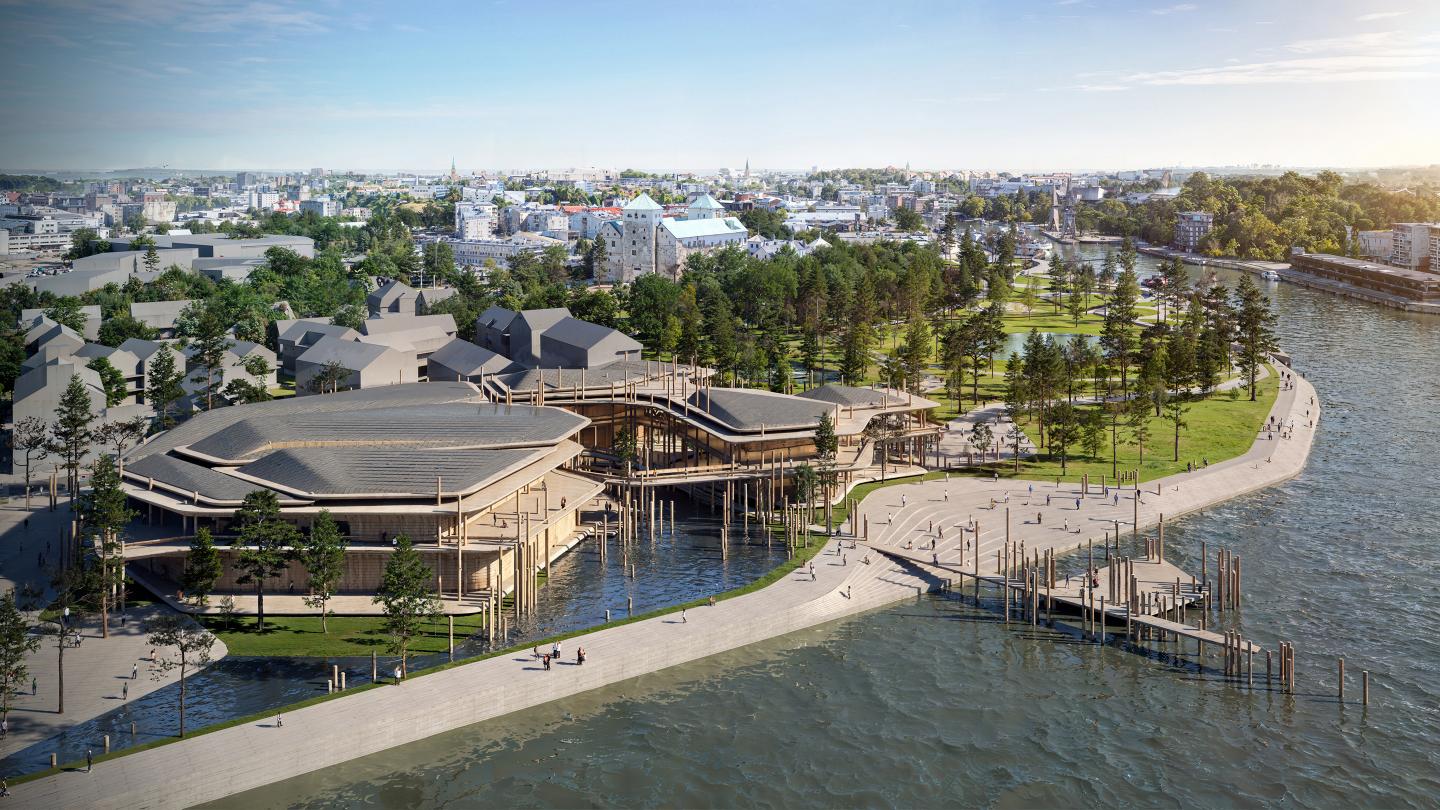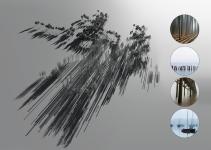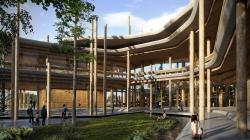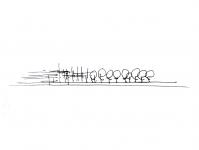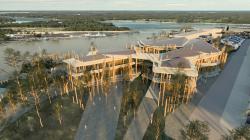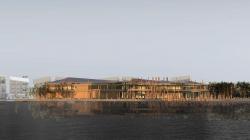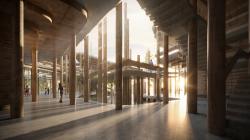Dynamic and versatile space where various cultural and natural elements converge. The term "FieldSpace" implies an intersection where culture, time, and nature come together, creating a multifaceted and interconnected environment.
INTRO| OBJECTIVE
The past and the future drive this project, merging contemporary geometries with traditional approaches, local industries, and sustainable principles. Together, they aim to create a timeless and unique piece of architecture for Turku.
This design harmoniously blends the spirit of wild forests with the tranquillity of the pier and sailing veils. The building, poised to become a new city landmark, distinguishes itself not through imposing strong geometries on the environment but by naturally standing out with gentle materials, colour mimesis, and subtle linear expression. It serves as a contemporary focal point without overshadowing the Turku Castle in the background.
The project’s goal is to foster awareness and connection to the natural outdoor life in everyday existence, recognizing the natural uniqueness of passages as integral parts of the city’s cultural and historical value.
Intending to cultivate blurred interior/exterior relationships, the building provides opportunities for human interaction and art exhibitions within intermediate spaces.
The building is conceived as three enclosed volumes, each dedicated to essential functions. Those volumes are linked by a semi-enclosed and possibly unheated area. This area will be harmoniously merged with nature, offering not only partial enclosure for specific events but also ensuring a perpetual activation of the site. It transforms into a purposeful open plaza for the community, maintaining its vibrancy even during intervals when the museum remains inactive.
Art, culture, and nature are intended to permeate every aspect of this architectural endeavour.
THE CONCEPT
The Pockets
The project was conceived as the convergence of three primary elements that permeate the building: the forest, the ocean, and the city. These elements coexist in every space of the intervention. The building, just naturally grows around them as a gentile component that allows users interact and be aware of the natural environment and immediate context. All public functions are strategically arranged, ensuring that every open, semi-open, and closed space becomes an opportunity for engagement with nature, art, and history. The woods, the water, and the city’s character serve as the driving forces behind the project. It was envisioned as a singular public space surrounded by functions, accessible at all times, even when the main functions are closed. The building was conceptualized as a highly flexible element, comprised of conforming but independent components that share lobbies, pre-function areas, and circulation spaces. These components can function independently or seamlessly come together to form a cohesive, compact building.
The Columns
The chosen design language originated from the fundamental concept of vertical columns and horizontal slabs. The aim was to abstract the notion of rigid grids by transforming the structure into a vibrant field of columns that organically emerges from the site, resembling trees in a wild forest. The spaces are intended to be traversed, cycled through, and discovered. The density of the column field provides opportunities for adjusting permeability and privacy based on the specific needs of each function. These columns act as gentle boundaries, guiding users on how to navigate the various fluid spaces. The materiality not only capitalizes on local resources and industries but also seeks to bring awareness to the historical and meaningful aspects of the materials, communicating their processes in the users’ everyday lives. Simultaneously, it imparts a sense of outdoor life in the woods, infusing the spaces with vivid and dynamic characteristics, creating a playful environment for families and children. The field of columns extends beyond the building’s interior to the exterior, blurring the boundaries between interior and exterior, natural and human. These columns serve not only as the primary structural feature but also transform into sculptural elements, lending a distinctive identity to the intervention. Additionally, they double as a pier extending into the water for access, a playground for kids, lighting features, and more.
The Landmark
The building aspires to become a significant landmark for the area, yet in a subtle and gentle manner. The identity of the field of columns will be easily recognizable from the water, forest, and city, simultaneously blending seamlessly with the colours and materials of its natural surroundings. Our goal was to forge a distinctive architectural language utilizing the natural resources and industries of the area. In doing so, we aimed to create a structure that not only stands out as a singular entity but also establishes a profound sense of belonging for both the area and its users. Our intention was to be easily recognized while maintaining a harmonious composition with the Turku Castle in the background.
CONSTRUCTABILITY
The structural design strategy prioritises efficient, economic and elegant principles, so that the system structure can support the architectural ambitions and also be a feature itself reducing the need to conceal the elements behind finishes. Engineered timber columns from locally harvested timber echo the Finnish forest and support lightweight concrete slabs. To minimise the carbon embodied within the structure whilst providing inherent thermal mass, voided concrete slabs are proposed which are estimated to reduce carbon by 25%. We will also look into cement replacements, lightweight and recycled aggregates to see whether further reductions are possible.
For the foundations a thorough review of the soil conditions will allow the optimum foundation strategy to be developed. It is envisaged that there may be a relatively high thickness of soft and/or silty soil present on the site and a conventional driven pile solution may be feasible, and we would compare this to other, ground improvement methods which may allow more innovation as well as lower carbon, shallow foundations to be developed. If the site is contaminated, a shallow foundation may also present benefits in terms of mitigation of any pathways to the ground water below. Overall, the site and project brief present a wonderful opportunity to not only provide a beautiful, functional and sustainable building for the community and visiting tourists alike, whilst also finding a new positive use for an area of the city with a fascinating history.
SUSTAINABILITY
The extreme climate of the regio demand a compact envelope for reduced heat losses and energy efficiency. The design takes a different approach of creating a series of semi outdoor spaces that can be at intermediate conditions between the indoor and the outdoors. This not only smoothens the temperature transitions for the users, but also with different grades of comfort, comes reduced energy requirement and not all spaces need to offer energy intensive close control environment. The glazing on the building is optimised as per the orientations. The North orientation has maximum solidity offering good thermal performance of the envelope for heat losses, while the south and east have increased glazing to allow for a seasonal solar control strategy. The building itself offers an opportunity to be flexible and adaptable depending on the season/ambient conditions.The roofs are slightly inclined to offer the perfect canvas for the integration of solar power (PVs) and give opportunities to borrow daylight into deep-plan exhibition/museum spaces.
2023
Project Name: FIELDSPACE MUSEUM OF HISTORY AND THE FUTURE
Location: Turku City in Finland
Project by: OF. STUDIO
Structures: Peter Corbett
Sustainability: studio4215
